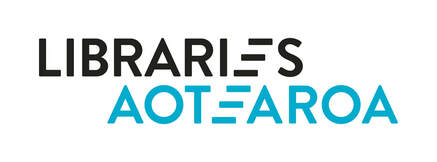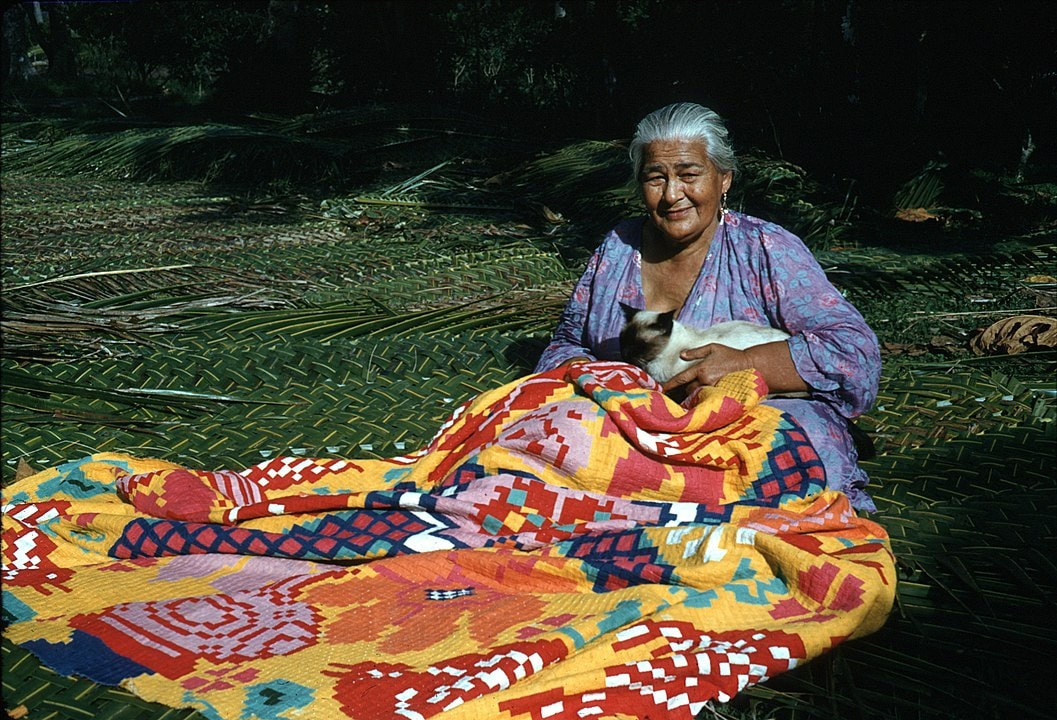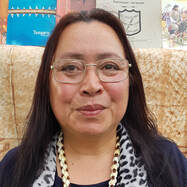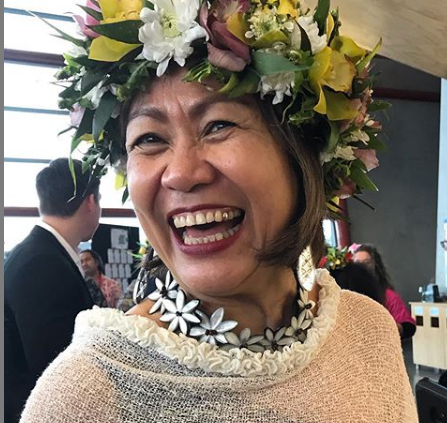Viewpoint: Tivaevae values and knowledge – strengthening connections online during COVID-19
|
A family wedding. Mum, mamas, and our family tivaevae (quilt) specialist (aunty) gathered. The wedding was discussed. Our family tivaevae for the bride and groom was discussed. Its design was agreed upon. Tasks allocated. They met regularly, working together on the tivaevae. Songs were sung, stories told, tears wiped away, laughter constantly present. Stitching together. Finally, complete. The hall was packed with family and friends, and at one end of the hall sat the bride and groom. I sat on the floor with the other children with a clear view of what was to come. The mamas were dressed in their finest, and each held a corner, a part of the tivaevae, and at the sound of the beating drums they danced, down the centre of the hall carrying the precious family tivaevae, to the bride and groom where they wrapped it around my cousin and her groom. We jumped up clapping and shouting whoop woo, as our mamas danced back. – Maryanne Marsters |
The tivaevae model by Teremoana Maua-Hodges from the Cook Islands, one of the Pacific nations within the realm of New Zealand, draws its structure from the tivaevae where stories of worlds and the lives within it, windows into cultures, languages, environments, identities, knowledges, and perspectives live.
(Futter-Puati & Maua-Hodges, 2019; Tualaulelei & McFall-McCaffery, 2019; Te Ava & Rubie-Davies, 2014;Te Ava & Page, 2018).
(Futter-Puati & Maua-Hodges, 2019; Tualaulelei & McFall-McCaffery, 2019; Te Ava & Rubie-Davies, 2014;Te Ava & Page, 2018).
Telescopes shrunk distance. Satellites removed distance. They enable those of us with open hearts and minds to sit within and amongst places, people, lives. To receive, share and co-construct knowledge and understanding. To experience the lenses of others – seeing who they/we are and why they/we do what they/we do; share/reciprocate knowledge, and abilities – not in order to devalue another’s lens, but to strengthen connections.
The talanoa workshop presented by the Pacific Information Management Network (PIMN) ‘Strengthening Connections in the Pacific’, at the LIANZA Conference 2019, brought library professionals in Aotearoa New Zealand and the Pacific Islands region into a space of ‘Tivaevae’. A talanoa where combined knowledge and understanding seek to foster and enhance connections with Pacific in the form of group tivaevaes and the tivaevae model. You can read a summary from the groups activity at this talanoa workshop here.
The talanoa workshop presented by the Pacific Information Management Network (PIMN) ‘Strengthening Connections in the Pacific’, at the LIANZA Conference 2019, brought library professionals in Aotearoa New Zealand and the Pacific Islands region into a space of ‘Tivaevae’. A talanoa where combined knowledge and understanding seek to foster and enhance connections with Pacific in the form of group tivaevaes and the tivaevae model. You can read a summary from the groups activity at this talanoa workshop here.
Using posters, Pearls of the South Pacific, Frangipani, Vaka of 5, and other groups presented a team tivaevae carrying themes of their understandings and knowledge on strengthening connections. These vafealoa’i, fakaa’apa’apa, alofa, and whānau included: partnerships; indigenous approaches; inclusion; decision making; visibility; familiarity; skills and expertise; interactions; development; strategies; networks; collaboration; collections; and unified focus. These tivaevaes combined nourished conversations, merging group concepts and understandings, into a growing, larger tivaevae for wider collaborations in our shared Pacific work and support network.
The tivaevae has a strong reliance on social interactions that foster collaboration – working as a team; teaching and learning from each other; sharing concepts, skills and knowledge. Tivaevae collaborators tautoko each other to make a creation that emulates people’s environments and moments in their lives – preserving their history, their existence. Knowledge. Rich data.
So, now we have this shared knowledge – this rich data. What happens to this after a workshop ends? Is it tossed around for a while, to then fade into the background? Or is it shared, built upon, shared some more, in a proactive deliberate way? If so, what, why, how, when? At more conferences, workshops, in research? Face-to-face? People’s skill levels, cultural competencies, priorities, commitments, time, busy work and personal lives present limitations. What can be the best fit? Is it in technology?
Post-conference, COVID-19 forces people all around the world into asking such questions, in more ways than one. We are looking at alternative ways of being, of working as teams, of collaboration, and maintaining appropriate social distancing as we operate electronically from our homes in small group bubbles.
Working from these bubbles, we are having to communicate and maintain the value of relationships, teamwork and collaboration to explore, tailor skills and knowledge, to engage and interact with each other. The tivaevae model is proving a robust way to do so. Like others, in the vein of the tivaevae model, music artists from the Cook Islands, living in cities throughout Te Moana-nui-ā-Kiwa are coming together on digital platforms, and creating pieces of music which when combined creating songs showcasing Cook Islands language, culture, environment, life. The result – a music tivaevae that has been posted and shared, and shared, and shared on social media (United Kuki’s, 2020).
COVID-19 is forcing people to think more creatively, en masse. COVID-19 is pushing people to look to technology and digital platforms as a vehicle to bring us back to some kind of normality within a social distancing frame. COVID-19 is also requiring New Zealanders to look within – at the inequalities, places and peoples whose lack of resources in the digital world are simply a reflection of their everyday life. A life of poverty and inequities – student and family access to technology, the internet, digital devices, food, study spaces in overcrowded homes, and financial hardship – are issues our most vulnerable face on a daily basis. Locally, our Pacific students, families and communities are the most vulnerable and will continue to be during and post COVID-19. COVID-19 also shines a light on how vulnerable our neighbours in the Pacific Islands are.
Prime Minister Jacinda Ardern said ‘these are unprecedented times’ (Radio New Zealand, 2020) pointing to change and, with that, the need for different ways of seeing, thinking, and doing. New Zealanders have been required to look at alternative ways of working and socialising, and we have turned to technology.
In summary, COVID-19 has presented us all with challenges, possibilities, and opportunities. Amongst those is an opportunity to replicate a tivaevae space, from a physical place to a virtual space as we seek to indigenise our virtual spaces – and how we articulate our tivaevae values online. We will need to share the knowledge, the rich data from the talanoa workshop, ‘Strengthening Connections in the Pacific’ in these virtual places, through building on established relationships, partnerships, technology, pushing creative limits, being open to change, and trying something new. The tivaevae concept and model, can successfully move into these virtual spaces. We seek to maintain the significance of face-to-face dynamics in new blended ways of being, which value all knowledges and peoples. In the end, we wish for all areas and sectors of society to be representative of our rich diversity.
Moving forward, our goal is to carry the values and knowledge of ‘Strengthening Connections in the Pacific’ into the new realities, challenges, potentials, opportunities provided by COVID-19. Tivaevae values can assist us in continuing to be kind – sharing our resources and spaces in society where they are most needed, for the benefit of all.
We wish to acknowledge all library and information professionals who attended the talanoa workshop ‘Strengthening Connections in the Pacific’ at LIANZA Conference 2019. Your open and accepting minds and hearts willing to receive and share have driven this Viewpoint article. We will see you on the other side of COVID-19.
Meitaki ma’ata Kia manuia, Soifua ma ia manuia
The tivaevae has a strong reliance on social interactions that foster collaboration – working as a team; teaching and learning from each other; sharing concepts, skills and knowledge. Tivaevae collaborators tautoko each other to make a creation that emulates people’s environments and moments in their lives – preserving their history, their existence. Knowledge. Rich data.
So, now we have this shared knowledge – this rich data. What happens to this after a workshop ends? Is it tossed around for a while, to then fade into the background? Or is it shared, built upon, shared some more, in a proactive deliberate way? If so, what, why, how, when? At more conferences, workshops, in research? Face-to-face? People’s skill levels, cultural competencies, priorities, commitments, time, busy work and personal lives present limitations. What can be the best fit? Is it in technology?
Post-conference, COVID-19 forces people all around the world into asking such questions, in more ways than one. We are looking at alternative ways of being, of working as teams, of collaboration, and maintaining appropriate social distancing as we operate electronically from our homes in small group bubbles.
Working from these bubbles, we are having to communicate and maintain the value of relationships, teamwork and collaboration to explore, tailor skills and knowledge, to engage and interact with each other. The tivaevae model is proving a robust way to do so. Like others, in the vein of the tivaevae model, music artists from the Cook Islands, living in cities throughout Te Moana-nui-ā-Kiwa are coming together on digital platforms, and creating pieces of music which when combined creating songs showcasing Cook Islands language, culture, environment, life. The result – a music tivaevae that has been posted and shared, and shared, and shared on social media (United Kuki’s, 2020).
COVID-19 is forcing people to think more creatively, en masse. COVID-19 is pushing people to look to technology and digital platforms as a vehicle to bring us back to some kind of normality within a social distancing frame. COVID-19 is also requiring New Zealanders to look within – at the inequalities, places and peoples whose lack of resources in the digital world are simply a reflection of their everyday life. A life of poverty and inequities – student and family access to technology, the internet, digital devices, food, study spaces in overcrowded homes, and financial hardship – are issues our most vulnerable face on a daily basis. Locally, our Pacific students, families and communities are the most vulnerable and will continue to be during and post COVID-19. COVID-19 also shines a light on how vulnerable our neighbours in the Pacific Islands are.
Prime Minister Jacinda Ardern said ‘these are unprecedented times’ (Radio New Zealand, 2020) pointing to change and, with that, the need for different ways of seeing, thinking, and doing. New Zealanders have been required to look at alternative ways of working and socialising, and we have turned to technology.
In summary, COVID-19 has presented us all with challenges, possibilities, and opportunities. Amongst those is an opportunity to replicate a tivaevae space, from a physical place to a virtual space as we seek to indigenise our virtual spaces – and how we articulate our tivaevae values online. We will need to share the knowledge, the rich data from the talanoa workshop, ‘Strengthening Connections in the Pacific’ in these virtual places, through building on established relationships, partnerships, technology, pushing creative limits, being open to change, and trying something new. The tivaevae concept and model, can successfully move into these virtual spaces. We seek to maintain the significance of face-to-face dynamics in new blended ways of being, which value all knowledges and peoples. In the end, we wish for all areas and sectors of society to be representative of our rich diversity.
Moving forward, our goal is to carry the values and knowledge of ‘Strengthening Connections in the Pacific’ into the new realities, challenges, potentials, opportunities provided by COVID-19. Tivaevae values can assist us in continuing to be kind – sharing our resources and spaces in society where they are most needed, for the benefit of all.
We wish to acknowledge all library and information professionals who attended the talanoa workshop ‘Strengthening Connections in the Pacific’ at LIANZA Conference 2019. Your open and accepting minds and hearts willing to receive and share have driven this Viewpoint article. We will see you on the other side of COVID-19.
Meitaki ma’ata Kia manuia, Soifua ma ia manuia
Kia orana
Ko Pacific toku moana
Ko Moana Roa toku vaka
Ko Kuki Airani, Tahiti, Kiribati toku motu
Ko Maryanne taku ingoa
My eyes look Asia-Pacific.
My skin is brown and proud.
My size is large and sexy.
My name is Maryanne Reuben Marsters.
That says Maryanne is the daughter of Reuben Marsters.
He, like fathers in days gone by answered the call to
come to this land of milk and honey.
We came.
Meitaki ma’ata
Ko Pacific toku moana
Ko Moana Roa toku vaka
Ko Kuki Airani, Tahiti, Kiribati toku motu
Ko Maryanne taku ingoa
My eyes look Asia-Pacific.
My skin is brown and proud.
My size is large and sexy.
My name is Maryanne Reuben Marsters.
That says Maryanne is the daughter of Reuben Marsters.
He, like fathers in days gone by answered the call to
come to this land of milk and honey.
We came.
Meitaki ma’ata
REFERENCES
Futter-Puati, D., & Maua-Hodges, T. (2019). Stitching tivaevae: A Cook Islands research method. AlterNative: An International Journal of Indigenous Peoples. Advance online publication. http://doi.org/c6k2
Newsroom. (2020). PM Jacinda Ardern’s full lockdown speech.https://www.newsroom.co.nz/2020/03/23/1096999/pm-jacinda-arderns-full-lockdown-speech
Radio New Zealand. (2020). Focus on Politics: Unprecedented Times. http://www.mpi.govt.nz/agriculture/rural-communities
Te Ava, A., & Page, Angela. (2018). How the Tivaevae Model can be Used as an Indigenous Methodology in Cook Islands Education Settings. Retrieved April 29, 2020, from https://www.researchgate.net/publication/327731061_How_the_Tivaevae_Model_can_be_Used_as_an_Indigenous_Methodology_in_Cook_Islands_Education_Settings/link/5bac3c69299bf13e604fa310/download
Te Ava, A., & Rubie-Davies, C.M. (2014). Akarakara akaouanga i te kite pakari o te Kuki Airani.Culturally responsive pedagogyhttps://www.researchgate.net/publication/260268139_Akarakara_akaouanga_i_te_kite_pakari_o_te_Kuki_AiraniCulturally_responsive_pedagogy
Tualaulelei, E., & McFall-Mccaffery, J. (2019). The pacific research paradigm: Opportunities and challenges. MAI Journal, 8 (2), 188-204. 10.20507/MAIJournal.2019.8.2.7
United Kuki’s. (2020, April 24). To Te Ao Nei [Video file]. Retrieved fromhttps://www.youtube.com/watch?v=svswYUhEXLI
Futter-Puati, D., & Maua-Hodges, T. (2019). Stitching tivaevae: A Cook Islands research method. AlterNative: An International Journal of Indigenous Peoples. Advance online publication. http://doi.org/c6k2
Newsroom. (2020). PM Jacinda Ardern’s full lockdown speech.https://www.newsroom.co.nz/2020/03/23/1096999/pm-jacinda-arderns-full-lockdown-speech
Radio New Zealand. (2020). Focus on Politics: Unprecedented Times. http://www.mpi.govt.nz/agriculture/rural-communities
Te Ava, A., & Page, Angela. (2018). How the Tivaevae Model can be Used as an Indigenous Methodology in Cook Islands Education Settings. Retrieved April 29, 2020, from https://www.researchgate.net/publication/327731061_How_the_Tivaevae_Model_can_be_Used_as_an_Indigenous_Methodology_in_Cook_Islands_Education_Settings/link/5bac3c69299bf13e604fa310/download
Te Ava, A., & Rubie-Davies, C.M. (2014). Akarakara akaouanga i te kite pakari o te Kuki Airani.Culturally responsive pedagogyhttps://www.researchgate.net/publication/260268139_Akarakara_akaouanga_i_te_kite_pakari_o_te_Kuki_AiraniCulturally_responsive_pedagogy
Tualaulelei, E., & McFall-Mccaffery, J. (2019). The pacific research paradigm: Opportunities and challenges. MAI Journal, 8 (2), 188-204. 10.20507/MAIJournal.2019.8.2.7
United Kuki’s. (2020, April 24). To Te Ao Nei [Video file]. Retrieved fromhttps://www.youtube.com/watch?v=svswYUhEXLI



